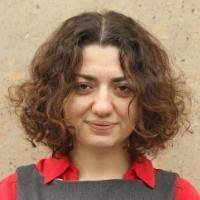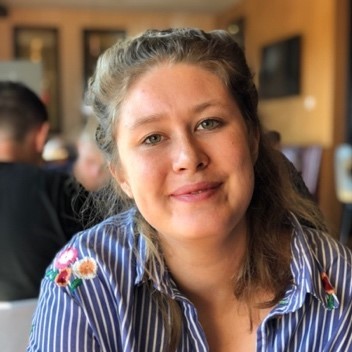Broken Grammar and Beyond
“Every day texts is full with grammatically anomalies”. Grammatical anomalies are defined as cases of atypical convention-breaking grammar, e.g. atypical usage of word order, grammatical words, derivations, and inflections. Grammatical anomalies both occur in texts produced by first language users and by second language users. In some cases, grammatical anomalies result in miscomprehension of the text, in some cases, they impact the recipient’s reading speed, and in other cases, they are not even noticed.

The research project Broken Grammar and Beyond (BGB) investigates what types of grammatical anomalies we produce in texts and how these texts are read and understood by others. Which grammatical anomalies are the most frequent, which affect reading speed, and which cause the most problems when it comes to understanding the message?
The project Broken Grammar & Beyond runs from 2018-2023 and is funded by Independent Research Fund Denmark (IRFD), the Sapere Aude-programme. Read IRFD's description of the project (in Danish).
We compare the types and frequencies of grammatical anomalies in texts produced by first language users of Danish to those produced by second language users of Danish. By means of controlled reading experiments, we investigate how language users understand texts with different types of grammatical anomalies – and by means of neuroimaging, we investigate the neural underpinnings of understanding language. This research is, among other things, relevant to language teachers and language professionals. It increases awareness of what makes a text readable, and it points to types of grammar that are challenging to language learners.
Broken Grammar and Beyond aims to develop a usage-based and neurocognitively grounded language processing model. The model will take into account that grammar is a complex phenomenon expressed through e.g. word order, case and gender of nouns, and that not all of these affect comprehension in the same way.
We ask questions relevant to everyday language users: When is a message understood despite atypical grammar, and when is it miscomprehended? What does it take to be understood?
BGB will address three overall research questions:
- What types of grammatical anomalies occur in texts written by first language users of Danish vs. texts written by second language users of Danish – and how frequent are these anomalies?
- How are these different types of naturalistic grammatical anomalies processed and comprehended by first language users of Danish?
- What are the neural underpinnings of these comprehension processes?
In the initial stages of the project, we examine what types of grammatical anomalies exist in naturally occurring language and how frequent they are. In the later stages, we examine how texts are comprehended, when they contain grammatical anomalies.
In collaboration with the Language Acquisition and Processing Lab (NTNU), we have conducted an eye tracking experiment examining how grammatical anomalies can affect reading speed and text comprehension.
In collaboration with the Center of Functionally Integrative Neuroscience, we have conducted a neuroimaging experiment (fMRI) of neural responses to grammatical anomalies in texts.
What is a grammatical anomaly?
We investigate a multitude of different types of convention-breaking grammar, for example:
- Atypical use of inflectional endings
- Atypical use of word order
- Atypical use of gender
- Omitted grammatical word
Studies of texts from language schools
As part of the project Broken Grammar and Beyond, we analyse the grammar of texts produced by second language learners of Danish. We collaborate with teachers and students at the language school Copenhagen Language Center and have collected essays from hundreds of adult students with different languages and different cultural backgrounds. The essays are written by hand with access to a dictionary, but no access to electronic remedies such as Google Translate.
First, we anonymise and digitalise the students’ texts. Then, we tag the texts manually for anomalies in four categories: orthography, morphology, syntax, and lexis. Finally, we do a fine-grained classification of the types of grammatical anomalies.
The studies will show what types of Danish grammar are particularly challenging when learning Danish.
Studies of texts from Danish high school students
Broken Grammar and Beyond also examines grammar in texts written by Danish high school students. The texts are tagged and analysed in collaboration with The Danish Language Council, who have collected texts from Danish high schools. All texts are anonymised, and consent forms have been signed. The texts are tagged manually, following the same procedure as for texts from language schools.
The studies of grammar in high school essays contribute with a quantitative view on grammatical anomalies in texts produced by first language users of Danish. Furthermore, the studies of high school essays may increase high school teachers’ awareness of their students’ specific challenges.
The project’s core group is based at the Department of Nordic Studies and Linguistics at the University of Copenhagen.
|
|
Line Burholt Kristensen is PI (principal investigator) of BGB and Associate Professor in Linguistics at the Department of Nordic Studies and Linguistics, University of Copenhagen. Her research focuses on grammar processing. From 2013 to 2017 Line was a postdoc at ProGram (a research project led by Associate Professor Kasper Boye, University of Copenhagen) where she investigated grammar processing through reading and listening experiments as well as neuroimaging studies (fMRI).
|
|
Katrine Falcon Søby is a PhD fellow in BGB. She holds an MA in Linguistics and Danish as a Second Language and has previously taught Danish at Copenhagen Language Center. In her PhD project, she investigates the types and frequencies of grammatical anomalies that occur in texts from speakers of Danish as a second language. She also investigates how first language users process different types of grammatical anomalies – i.e. which parts of Danish grammar are the most important to master as a learner if you want to be comprehensible.
|
|
 |
Byurakn Ishkhanyan has a PhD in neuro- and psycholinguistics. She was a postdoc at BGB from February to December 2021 and examined how the brain processes anomalies in verbal inflections using brain scanning (fMRI).
|
 |
Maja Mittag works as a student assistant on BGB since September 2021. Maja is an MSc student of IT & Cognition at the University of Copenhagen and has a BA in Functional-Cognitive Linguistics. She primarily works on BGB’s experiments (on-site and online), including their setup, development of experimental design and stimuli, execution, and statistical analyses.
|
| Julie Johanna Hansen worked as a student assistant on BGB from January 2019, while she was an MA student of Linguistics at the University of Copenhagen. She annotated data and helped with experiments. In the fall of 2018, Julie was a BGB intern working with anomalies in verbal inflections. | |
 |
Caroline Amalie Ørum-Hansen worked as a student assistant on BGB from the summer of 2020 to the spring of 2021, while she was a BAstudent of Linguistics at the University of Copenhagen. Caroline worked with data annotation, categorization, development of stimuli for experiments, and testing of pilot trials. |
|
Kasper Rud Jensen was a student assistant on BGB in the fall of 2018 while he was a BA student of Linguistics at the University of Copenhagen. Kasper primarily worked with typing and data annotation,. In his BA project, Kasper conducted a contrastive analysis of definiteness markers in nominal phrases from learners, who have Polish, Russian, or Spanish as their first language. |
|
 |
Katrine Ursbak was an intern at BGB in the spring of 2019. Katrine has an MA in Psychology of Language from the University of Copenhagen. Her main assignments were data annotation and dissemination of the project. |
|
Peter Hagoort is Professor in Cognitive Neuroscience, director of Max Planck Institute for Psycholinguistics in Nijmegen, The Netherlands, and the Centre for Cognitive Neuroimaging at Radboud University, Nijmegen, The Netherlands. In his research, he uses neuroscientific techniques such as ERP, MEG, PET, and fMRI in order to investigate language disorders such as aphasia, dyslexia, and autism.
Peter is an advisory board member of BGB and is collaborating with BGB on neuroscientific studies.
|
|
|
Mila Dimitrova Vulchanova is Professor at the Department of Language and Literature, Norwegian University of Science and Technology (NTNU). She is head of NTNU’s Language Acquisition and Language Processing Lab. Mila’s research interests are, among others, language and cognition, language learning, and language comprehension. She is involved in several research projects, e.g. as PI in the Horizon 2020 project DCOMM (Deictic Communication). Mila is an advisory board member of BGB and is collaborating with BGB on psycholinguistic reading studies.
|
|
|
Mikkel Wallentin is Associate Professor in Cognitive Science at the School of Communication and Culture, Aarhus University. Since 2002, he has conducted neuroscientific research at the Center of Functionally Integrative Neuroscience, CFIN, at Aarhus University, and the Center for Semiotics at Aarhus University. His research focuses on neuroscientific aspects of language processing. Mikkel is an advisory board member of BGB and is collaborating with BGB on neuroscientific studies.
|
|
|
Kasper Boye is Associate Professor at the Department of Nordic Languages and Linguistics, University of Copenhagen. His research focuses on grammar, grammaticalization, and semantics.
With Professor Peter Harder, he has developed the ProGram theory of grammar (Boye & Harder 2012), which is part of the theoretical basis of the BGB project.
|
|
|
Jørgen Schack is Senior Research Associate in The Danish Language Council where he primarily edits the official dictionary of Danish standard orthography (Retskrivningsordbogen). His research interests are word formation and lexical semantics. In BGB, Jørgen is involved in the principles for the tagging of anomalies in texts from the Danish high schools.
Read more about Jørgen and his research (in Danish).
|
|
 |
Furthermore, former Research Associate at The Danish Language Council Philip Diderichsen has been involved in the principles for the tagging of anomalies in the texts from the Danish high schools. Former research assistant at The Danish Language Council Katrine Lund Støiholm and former student assistant Amalie Arleth Møller have assisted with the error tagging of texts from Danish high school students.
|
 |
Copenhagen Language Center collaborates with BGB on the collection of texts from second language learners of Danish.
|
- Søby, K. F., & Kristensen, L.B. (2019). Hjælp! Jeg har mistede min yndlings rød taske: Et studie af grammatikafvigelser. Ny forskning i grammatik. 26. 89-104. (In Danish)
Media coverage
- Read the Independent Research Fund Denmark's description of the BGB project (in Danish).
- Article by Lone Frank in the Danish newspaper Weekendavisen from the 2nd of February 2018 (section 4 “Ideer”, p. 8). (in Danish).
- Coverage of the project on forskningsformidling.dk (in Danish).
- Article from the Norwegian newspaper Aftenposten from the 3rd of February 2020 on the processing of language errors (requires a login and is in Norwegian).
Related scientific publications
- Boye, K. & Harder, P. 2012. "A usage-based theory of grammatical status and grammaticalization". 88. 1-44.
- Kristensen, L.B., & Wallentin, M. (2015). Putting Broca's region into context: fMRI evidence for a role in predictive language processing. Willems, R.M. (ed.). Cognitive Neuroscience of Natural Language Use. Cambridge: Cambridge University Press. 160-181.
If you are a student of e.g. Linguistics, Danish, or Cognitive Science, and if you are interested in the BGB project, you are welcome to contact us regarding e.g. an internship or supervision of university projects (e.g. your BA project or MA thesis).
You can contact Line at burholt@hum.ku.dk (or Katrine at wqd565@hum.ku.dk).
News
-
BGB presents the project's results at three conferences in 2022
2022.04.28 -
Article in the Norwegian newspaper Aftenposten about being annoyed by language errors
2020.02.03 -
Eye tracking in Norway
2019.09.01 -
BGB participates in international conferences
2019.06.12 -
Visit from Adam Mickiewicz University in Poznań, Poland
2019.01.21 -
Welcome to Katrine Ursbak, new intern at BGB
2019.01.14 -
BGB’s new student assistant is Julie Johanna Hansen
2019.01.01 -
Welcome to Kasper Rud Jensen, new student assistant.
2018.09.19 -
Welcome to Julie Johanna Hansen, new BGB intern.
2018.08.27 -
Welcome to PhD fellow Katrine Falcon Søby.
2018.05.01 -
BGB begins!
2018.02.01
